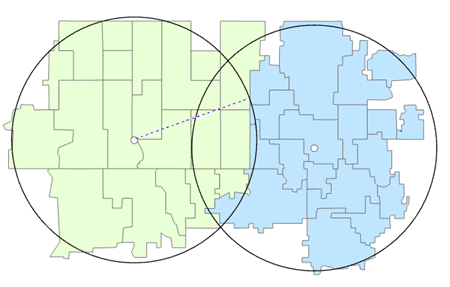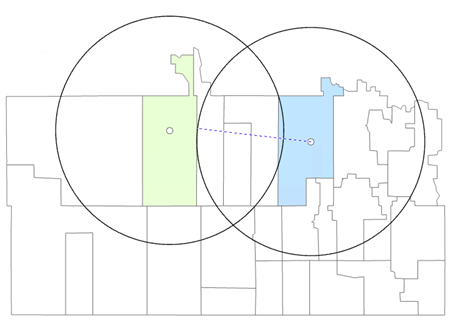| Label | Explanation | Data Type |
Input Territory Solution
| The Territory Design solution layer that will be used in the analysis. | Group Layer; Feature Dataset; String |
Level | The level to which the distance parameters will be applied. | String |
Distance Type
(Optional) | Specifies the method of travel that will be used for the distance calculation. When a network data source is selected, additional travel mode options will be dynamically populated. The following distance methods are supported:
| String |
Measure Units
(Optional) | Specifies the type of measuring units that will be used.
| String |
Maximum Territory Radius
(Optional) | The maximum radius of the territory. | Double |
Territory Buffer Distance
(Optional) |
The radius of the territory buffer. | Double |
Minimum Distance Between Centers
(Optional) | The minimum distance between territory centers. | Double |
Network Data Source
(Optional) | The network dataset on which the network distance calculation will be performed. The parameter requires a locally installed dataset. | Network Dataset Layer |
Build Network Index
(Optional) | Specifies whether a network index will be built. A network index will improve performance when solving the territory solution.
| Boolean |
Travel Direction
(Optional) | Specifies the direction of travel between stores and customers.
| String |
Time of Day
(Optional) | The time and date that will be used when calculating distance. | Date |
Time Zone
(Optional) | Specifies the time zone of the Time of Day parameter.
| String |
Search Tolerance
(Optional) | The search tolerance that will be used for locating territories on the network. Territories that are outside the search tolerance will be left unlocated. This parameter requires a distance value and units for the tolerance. The default value is 5000 meters. | Linear Unit |
Derived Output
| Label | Explanation | Data Type |
| Updated Territory Solution | The updated territory solution. | Group Layer |


